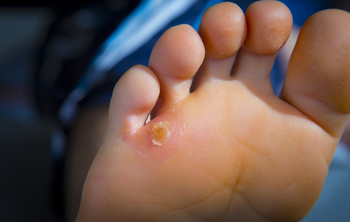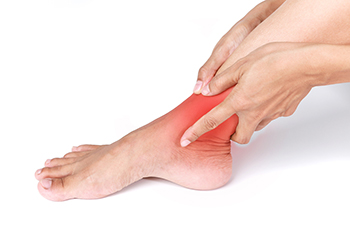Connect With Us
Blog
Items filtered by date: May 2025
Causes of Corns from Mechanical Hyperkeratosis

Corns are thickened areas of skin that develop due to repeated pressure or friction, often as a result of mechanical hyperkeratosis. This condition occurs when the skin responds to stress by producing excess keratin, leading to hardened layers. Footwear that does not provide adequate support or fit can increase pressure on certain parts of the foot, encouraging corn formation. Abnormal foot mechanics, such as overpronation or structural deformities, can also create uneven pressure points during movement. Individuals who engage in high levels of physical activity may experience repetitive stress on their feet, further contributing to the development of corns. Corns can be painful and may cause difficulty in completing daily activities. If you have developed a corn, it is suggested that you consult a podiatrist who can offer effective relief and prevention tips.
Corns can make walking very painful and should be treated immediately. If you have questions regarding your feet and ankles, contact Jeffrey Radack, DPM of Texas Regional Foot & Ankle Clinics. Our doctor will treat your foot and ankle needs.
Corns: What Are They? And How Do You Get Rid of Them?
Corns are thickened areas on the skin that can become painful. They are caused by excessive pressure and friction on the skin. Corns press into the deeper layers of the skin and are usually round in shape.
Ways to Prevent Corns
There are many ways to get rid of painful corns such as:
- Wearing properly fitting shoes that have been measured by a professional
- Wearing shoes that are not sharply pointed or have high heels
- Wearing only shoes that offer support
Treating Corns
Although most corns slowly disappear when the friction or pressure stops, this isn’t always the case. Consult with your podiatrist to determine the best treatment option for your case of corns.
If you have any questions, please feel free to contact our office located in McKinney and Coppell, TX . We offer the newest diagnostic and treatment technologies for all your foot care needs.
Are Bunions Affecting Your Everyday Life?
Is It a Sprained or Broken Ankle?

Telling whether an ankle injury is a sprain or a fracture can be problematic. A sprained ankle occurs when the ligaments that support the joint are stretched or torn, often from twisting or rolling the ankle. Sprains can range in severity, from mild overstretching to complete ligament tears. In contrast, a broken ankle involves a fracture of one or more bones, typically the tibia, fibula, or talus. A fracture may be simple with a clean break or complex with multiple fragments. While both injuries can cause swelling, bruising, and pain, a fracture often results in more severe pain and the inability to bear weight. Proper diagnosis may require an X-ray to distinguish between the two. Treatment varies significantly, so it is suggested that you promptly consult a podiatrist for an accurate diagnosis and appropriate treatment solutions.
Foot and ankle trauma is common among athletes and the elderly. If you have concerns that you may have experienced trauma to the foot and ankle, consult with Jeffrey Radack, DPM from Texas Regional Foot & Ankle Clinics. Our doctor will assess your condition and provide you with quality foot and ankle treatment.
Foot and ankle trauma cover a range of injuries all over the foot; common injuries include:
- Broken bones
- Muscle strains
- Injuries to the tendons and ligaments
- Stress fractures
Symptoms
Symptoms of foot and ankle injuries vary depending on the injury, but more common ones include:
- Bruising
- Inflammation/ Swelling
- Pain
Diagnosis
To properly diagnose the exact type of injury, podiatrists will conduct a number of different tests. Some of these include sensation and visual tests, X-rays, and MRIs. Medical and family histories will also be taken into account.
Treatment
Once the injury has been diagnosed, the podiatrist can than offer the best treatment options for you. In less severe cases, rest and keeping pressure off the foot may be all that’s necessary. Orthotics, such as a specially made shoes, or immobilization devices, like splints or casts, may be deemed necessary. Finally, if the injury is severe enough, surgery may be necessary.
If you have any questions, please feel free to contact our office located in McKinney and Coppell, TX . We offer the newest diagnostic and treatment technologies for all your foot care needs.
Surgical Options for Treating Flat Feet

Foot surgery for flat feet may be recommended when conservative treatments do not relieve pain or restore function. One common procedure, termed medial displacement calcaneal osteotomy, involves shifting the heel bone inward to improve foot alignment and support the arch. Lateral column lengthening is another technique that adds bone to the outer side of the foot, helping to restore proper structure and reduce flattening. The flexor digitorum longus transfer uses a nearby tendon to support the arch by reinforcing the weakened or damaged posterior tibial tendon. Each of these surgical methods aims to correct deformity, improve stability, and reduce pain. Recovery typically involves rest, rehabilitation, and a gradual return to activity. A podiatrist can determine the best approach based on the severity and cause of flat feet. If you have flat feet and are experiencing chronic discomfort, it is suggested that you contact a podiatrist who can help you determine if surgery is right for you.
Foot surgery is sometimes necessary to treat a foot ailment. To learn more, contact Jeffrey Radack, DPM of Texas Regional Foot & Ankle Clinics. Our doctor will assist you with all of your foot and ankle needs.
When Is Surgery Necessary?
Foot and ankle surgery is generally reserved for cases in which less invasive, conservative procedures have failed to alleviate the problem. Some of the cases in which surgery may be necessary include:
- Removing foot deformities like bunions and bone spurs
- Severe arthritis that has caused bone issues
- Cosmetic reconstruction
What Types of Surgery Are There?
The type of surgery you receive will depend on the nature of the problem you have. Some of the possible surgeries include:
- Bunionectomy for painful bunions
- Surgical fusion for realignment of bones
- Neuropathy decompression surgery to treat nerve damage
Benefits of Surgery
Although surgery is usually a last resort, it can provide more complete pain relief compared to non-surgical methods and may allow you to finally resume full activity.
Surgical techniques have also become increasingly sophisticated. Techniques like endoscopic surgery allow for smaller incisions and faster recovery times.
If you have any questions, please feel free to contact our office located in McKinney and Coppell, TX . We offer the newest diagnostic and treatment technologies for all your foot care needs.
Common Pickleball Foot and Ankle Injuries

Pickleball has become a popular sport among people of all ages, but the quick lateral movements, abrupt stops, and sudden pivots can lead to various foot and ankle injuries. Common pickleball injuries include ankle sprains, tendon inflammation, plantar fasciitis, and fractures on the inner side of the ankle. These injuries often occur when a player twists the ankle or lands unevenly during play. Fractures involving the inner ankle may require immobilization or surgery, depending on the severity. A podiatrist can evaluate your injury through a physical exam and imaging tests to determine the appropriate course of treatment. Medical care may involve casting, supportive devices, or surgery to stabilize the bones and restore function. Without proper treatment, these injuries can lead to chronic pain or instability, especially in the ankle joint. If you have sustained a foot or ankle injury while playing pickleball, it is suggested that you seek treatment from a podiatrist.
Ankle and foot injuries are common among athletes and in many sports. They can be caused by several problems and may be potentially serious. If you are feeling pain or think you were injured in a sporting event or when exercising, consult with Jeffrey Radack, DPM from Texas Regional Foot & Ankle Clinics. Our doctor will assess your condition and provide you with quality foot and ankle treatment.
Common Injuries
The most common injuries that occur in sporting activities include:
- Achilles Tendonitis
- Achilles Tendon Rupture
- Ankle Sprains
- Broken Foot
- Plantar Fasciitis
- Stress Fractures
- Turf Toe
Symptoms
Symptoms vary depending upon the injury and in some cases, there may be no symptoms at all. However, in most cases, some form of symptom is experienced. Pain, aching, burning, bruising, tenderness, tightness or stiffness, sensation loss, difficulty moving, and swelling are the most common symptoms.
Treatment
Just as symptoms vary depending upon the injury, so do treatment options. A common treatment method is known as the RICE method. This method involves rest, applying ice, compression and elevating the afflicted foot or ankle. If the injury appears to be more serious, surgery might be required, such as arthroscopic or reconstructive surgery. Lastly, rehabilitation or therapy might be needed to gain full functionality in the afflicted area. Any discomfort experienced by an athlete must be evaluated by a licensed, reputable medical professional.
If you have any questions please contact our office located in McKinney and Coppell, TX . We offer the newest diagnostic and treatment technologies for all your foot and ankle needs.

